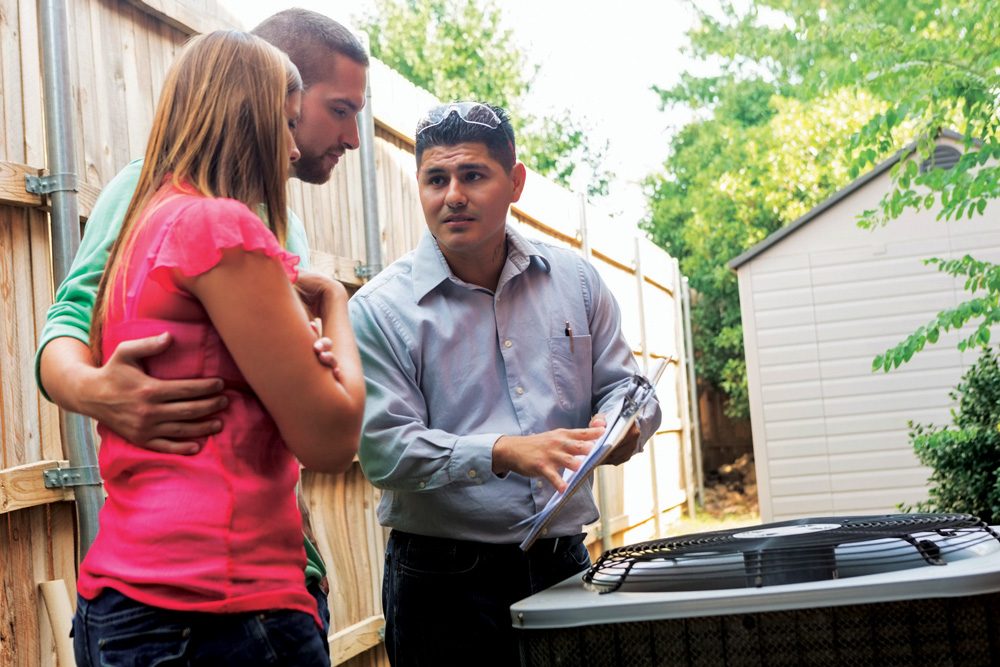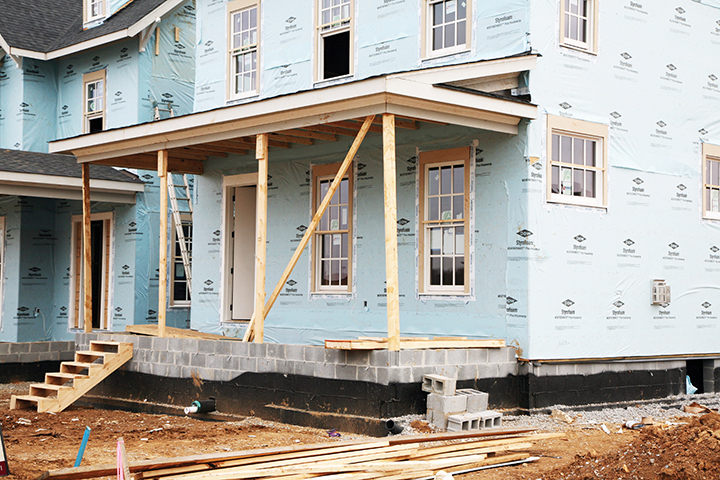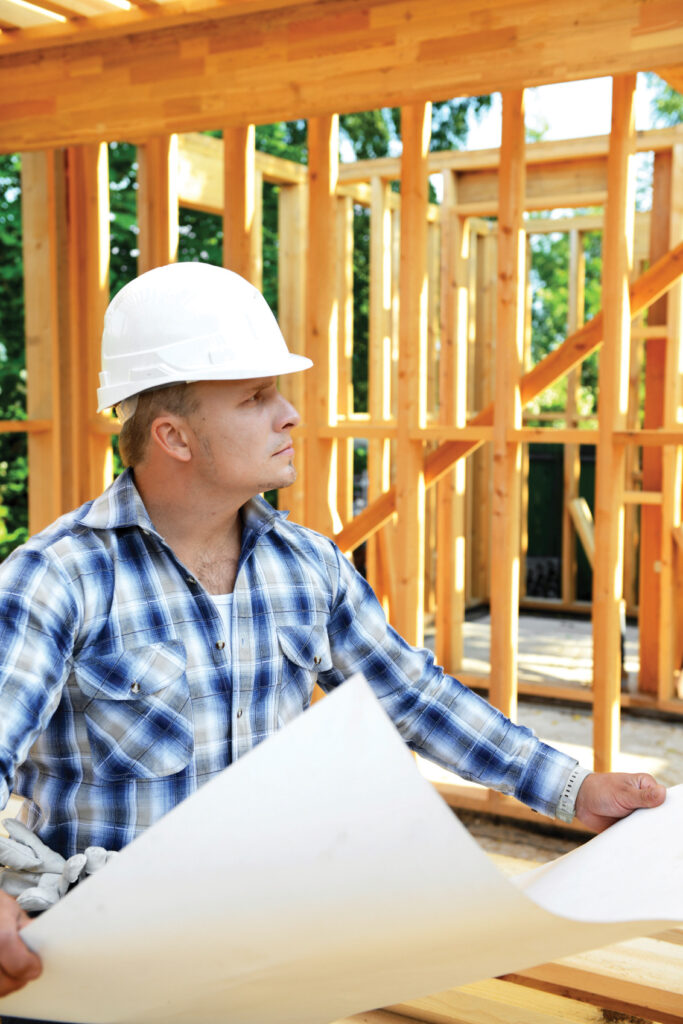[vc_row][vc_column][vc_column_text]www.nahb.org and www.newhomesource.com
 Before a homeowner goes to settlement on the purchase of a newly constructed home, you and the homebuyer should do a walk-through to conduct a final inspection. This walk-through will provide an opportunity to spot items which may need to be corrected or adjusted, educate the buyer about the way the new home works and what their responsibilities are, and answer any questions the homebuyer doesn't understand.
Before a homeowner goes to settlement on the purchase of a newly constructed home, you and the homebuyer should do a walk-through to conduct a final inspection. This walk-through will provide an opportunity to spot items which may need to be corrected or adjusted, educate the buyer about the way the new home works and what their responsibilities are, and answer any questions the homebuyer doesn't understand.
How Things Operate
When you buy a new appliance such as a washing machine, you usually have to read the instructions before you understand how to use all of the features. With a new house, the buyer will be overwhelmed with new appliances, systems, and maybe even ‘smart’ features. Not only will it help immensely if someone takes the time to show them how to operate all of these components and gadgets, but it shows that you care about the home and take pride in your finished craftmanship.
Maintenance Responsibilities
Part of your walk-through should be educating the buyer about maintenance and upkeep responsibilities. When you provide your buyers with a ten-year warranty, workmanship and materials are covered for one year. However, such warranties do not cover problems that develop because of failure to perform required maintenance. RWC/HOME of Texas provides a clearly written warranty booklet explaining what’s covered, what’s not covered, the responsibilities of new homeowners, and actions required citing specific guidelines and standards.
Builder Visits During the Year
Each builder is different, however, typically builders schedule two visits during the first year — one near the beginning and the other near the end — to make necessary adjustments and to perform work of a non-emergency nature. Explain to your client that you won’t be rushing out immediately for a problem such as a nail pop in your drywall. Such problems occur because of the natural settling of the house and are best addressed in one visit near the end of the first year.
Your Inspection Checklist
 Creating a checklist when inspecting the house is key to organization and cognizance. The list should include everything that needs attention, and you and the homebuyer should agree to a timetable for repairs. Explain to the buyer that it’s best to remedy problems before they move in, because it is easier to work in an empty house. However, some items may have to be corrected after move-in. For instance, if the walk-through is in the winter, landscaping adjustments may be delayed until spring.
Creating a checklist when inspecting the house is key to organization and cognizance. The list should include everything that needs attention, and you and the homebuyer should agree to a timetable for repairs. Explain to the buyer that it’s best to remedy problems before they move in, because it is easier to work in an empty house. However, some items may have to be corrected after move-in. For instance, if the walk-through is in the winter, landscaping adjustments may be delayed until spring.
It is important to be thorough and observant. Examine all surfaces of counters, fixtures, floors and walls for possible damage. Sometimes disputes arise because a buyer may discover a gouge in a countertop after move-in, and there is no way to prove whether it was caused by the builder's workers or the buyer's movers. Many builders ask their buyers to sign a form at the walk-through stating that all surfaces have been inspected and that there is no damage other than what has been noted on the walk-through checklist.
In preparation for the walk-through and to ensure everything goes smoothly and efficiently, educate your homebuyers with these walk-through “Dos and Don’ts”.
DO
- Make a list in advance of any questions about maintenance/warranty procedures.
- Bring pens, paper, a clipboard, digital camera or phone to take notes and photos.
- Bring the purchase agreement, RWC/HOME sample warranty book, customer service manual, selection sheets, diagrams and landscape and pool plans, if applicable.
- Wear clothing that is appropriate for walking a construction site, including closed-toe shoes.
- Park in the street, not the driveway, especially if the home is still under construction.
- Verify the expected dates for completion of repairs, if any are needed, and get a copy of the completed punch list before you leave the site.
DON’T
- Be late for the walkthrough. Builders have busy schedules and may have appointments with other customers on the same day.
- Bring pets, children or other family members and friends. You’ll need to devote your full attention to what is being presented.
- Rush through the walkthrough. Take your time and be thorough.
- Be shy about asking a lot of questions.
On that note, the homebuyer will most likely ask a lot of questions during the walk-through and take notes on the answers. Be patient. This is the dream home they’ve been anxiously waiting to move into for months and they want to make sure everything is up to par and in perfect working order. It is important to view the walk-through as a positive learning experience that will enhance the enjoyment of your client’s new home for years to come. And furthermore, a genuine, caring and thorough home builder will get all the praise and kudos through word of mouth - the most powerful (and free) form of advertising![/vc_column_text][/vc_column][/vc_row]

Due to advancements in technology and the increasing demand for affordable homes, modular construction continues to increase in popularity. In fact, modular home construction can often go toe-to-toe with, or in some cases even out-perform, site-built homes.
There are several benefits of modular construction for both the contractor and the homebuyer. Speed is a big factor. Since each phase of construction is carefully planned out, there are few last-minute problems or conflicts that will result in delays or plan revisions. Modular homes are typically built 33% faster with greater efficiency than a site-built home. Think about the countless individual pieces of material a site-built home needs from start to finish. Of course, the prefabrication phase uses many of these same materials, but once out of the factory, a modular home requires only connecting several large-scale components. At this point, delays including supply and delivery issues, are often kept to a minimum.
Prefabrication can also reduce the cost and time to build a home by a significant amount in several ways. First and foremost, factories are climate controlled, which means there are no weather-related construction delays adding time and money to the project. Secondly, there are also no cost over-runs from “no-show subs”. Subcontractors are already there in the factory, eliminating the need to find reliable skilled tradesmen. And third, materials are generally bought from suppliers through volume purchasing, thus getting better prices all the while controlling inventory with less waste.
Speaking of wasted materials, stick built homes tend to be less environmentally friendly than their modular counterpart. According to a National Association of Home Builders (NAHB) study, an estimated 8,000 pounds of waste is created from the construction of a 2,000 square foot home. The majority of that is wood, cardboard, and drywall and almost all of that waste ends up in landfills. Conversely, any extra materials or waste from a modular home is recycled.
There is however one thing that both modular and stick built homes have in common, and that is the need for a written insured new home warranty. As an RWC/HOME of Texas member, you know first-hand the benefits of providing a warranty on your homes. The construction industry comes in all shapes and sizes and so do warranties. Be sure to check out all of our risk management services and warranty products or call your Account Executive for more information.
 You and your crew have been working hard these past few months. In fact, you’re ahead of schedule. Then, you get a call from one of your jobsites. A woman tripped over a piece of scrap lumber and fell on the sidewalk in front of one of your nearly finished houses. None of your crew saw it happen since they were working inside. Your jobsite supervisor offered to call 911, but the lady seemed more embarrassed about what she described as her “accident proneness” and politely refused the offer. After that, she went on her way. No one bothered to get her name or contact information. You heave a sigh of relief and think all’s well that ends well. Still, you can’t shake the feeling; is there anything more you should have done?
You and your crew have been working hard these past few months. In fact, you’re ahead of schedule. Then, you get a call from one of your jobsites. A woman tripped over a piece of scrap lumber and fell on the sidewalk in front of one of your nearly finished houses. None of your crew saw it happen since they were working inside. Your jobsite supervisor offered to call 911, but the lady seemed more embarrassed about what she described as her “accident proneness” and politely refused the offer. After that, she went on her way. No one bothered to get her name or contact information. You heave a sigh of relief and think all’s well that ends well. Still, you can’t shake the feeling; is there anything more you should have done?
Unfortunately, there isn’t much you can do. What’s the use reporting that an unknown woman fell at one of your jobsites, refused medical attention and disappeared. However, that doesn’t mean this isn’t a Premises / Operations claim under your General Liability policy. Many injuries take time to manifest indications of how serious they really are. The person can be in mild shock and truly believe they aren’t hurt. As they begin feeling pain, sometimes days later, they go to the ER and file the claim under their medical insurance. The medical insurer discovers where the injury happened and eventually seeks reimbursement against your general liability company. Now you may have to explain why nothing was reported. This could impact your renewal pricing. If the claim spirals into a really large loss, you may even face nonrenewal.
All this can be avoided by establishing and following a simple procedure for dealing with incidents involving the public. Whether they happen to a person or their property, the following suggestions may serve as a general guideline to assist you in setting up an Incident Reporting Procedure:
As soon as you learn of any accident or incident involving the public find out if anyone is injured.
• If someone is hurt, call 911. Stay with the person until first responders arrive and follow any instructions they may give.
• Don’t move the person unless you have to in order to protect them from further injury.
• If you administer first aid, make sure you, or someone you know is competent to do so.
• Don’t admit guilt or accuse anyone.
• Your focus is to keep the injured person calm and make sure they get the emergency medical attention they need.
• If the person refuses medical aid, don’t try to force them. Try to get their name, phone number and address, but don’t insist if they prefer not to talk to you.
• If someone’s property has been damaged, call 911 if first responders are needed to prevent the accident from getting worse - such as a fire spreading.
• Try to get the names and contact information of any witnesses. Keep in mind these may include neighbors or passersby.
• Without putting yourself or others at risk, do what you reasonably can to prevent further injury to people or damage to property.
• Contact your general liability insurance company as soon as you can. Give them all the information you have gathered.
• Put your Incident Reporting Procedure in writing. Make sure everyone in your organization is aware of it. Review it often at periodic safety meetings.
To sum up, a premises/operations claim is a claim under general liability when a member of the public is injured or their property is damaged at any place related to your business over which you have direct, or indirect control.* The extent of injuries or damage may not be apparent at the time of the accident, but knowing as much as possible as soon as possible can be critically important when and if the accident develops into a claim.
WANT TO EARN UP TO 25% OFF YOUR GENERAL LIABILITY PREMIUM?
If you are insured with the RWC INSURANCE ADVANTAGE, having a written Incident Reporting Procedure as part of a formal safety program can qualify you for significant discounts.**
For more information, visit our website: rwcinsuranceadvantage.com. Or if you’d prefer speaking to one of our licensed agents, give us a call at 1-866-454-2155.
*This generally describes a claim for premises/operations third party liability damages. The various terms, conditions and exclusions in the General Liability Policy must be established to determine if a claim is, in fact, a covered loss.
**Discounts are subject to all other underwriting criteria and are not guaranteed.[/vc_column_text][/vc_column][/vc_row]

Do you know your Account Executive? Are you aware of everything that your Account Executive (A.E.) can do for you? If you answered no to either of these questions, it is time to get acquainted!
Each state is assigned a specific A.E. who is more than just a product salesperson. You may have only interacted with one another when you initially signed up to become a member. Since you may have discussed your initial enrollment process with them over the phone, it is not always easy to recall with whom you spoke. To find your specific representative, you can call into our main office at 800-247-1812 (Texas: 800-445-8173) to inquire or visit our website and click the "Find Your Account Executive" link within the Builder tab's drop-down menu.
Your A.E. serves as more than an initial contact to guide you through the process, they are also your liaison and program concierge. Their role is to help you develop a suitable program for your business. As a member, you have access to a full array of programs and options. For example, if you desire to obtain a quote for liability insurance, wish to offer appliances coverage, or need additional training set up for your team, your A.E. can make these arrangements.
As the end of the fiscal year approaches, common practice dictates that a performance evaluation analyzing the prior year will be completed. Ultimately, it is a time in which new methods or ideas may be slated for implementation with the intention of improving the overall corporate health. Setting aside time to review your warranty coverages and comparing how your business has developed or changed can be a vital part of this process, the purpose of which is to aid in ensuring that a thorough evaluation has been considered. Since businesses can fluctuate from year to year, RWC/HOME recognizes that your initial warranty options may no longer work as a ‘one-size-fits-all’ solution. This is where your Account Executive can work with you to develop the best plan which complements these fluctuations.
If the timing for this sort of evaluation is currently not quite appropriate, keep in mind that your A.E. will periodically be reaching out to you via phone, email, or mailings. However, you do not have to wait for them to contact you to initiate the line of communication. When something from RWC/HOME passes over your desk, let it serve as a reminder to get in touch. Once it is time to think through all the ways in which your business may have developed or changed after your initial enrollment, your A.E. is your best resource. Setting a meeting with your RWC/HOME Account Executive will allow you the opportunity to review each of the servicing options at your disposal. Of the tools in your arsenal, the relationship you develop with your representative is a key component. Remember that they are your partners, meant to serve as a support system for your company, now and into the future.
 Warranties come in all shapes and sizes and if you are looking for something besides the "traditional" new home warranty, RWC's Customized State Warranty (CSW)* is the answer! This warranty is the most unique and specialized new home warranty program in the industry. Each customized warranty is crafted specifically to meet each state’s statutes regarding new home warranties. The Builder’s liability is limited and individual state requirements for coverage are included, as applicable. RWC’s insurer covers warranted structural failures from day 1 throughout the entire warranty term.
Warranties come in all shapes and sizes and if you are looking for something besides the "traditional" new home warranty, RWC's Customized State Warranty (CSW)* is the answer! This warranty is the most unique and specialized new home warranty program in the industry. Each customized warranty is crafted specifically to meet each state’s statutes regarding new home warranties. The Builder’s liability is limited and individual state requirements for coverage are included, as applicable. RWC’s insurer covers warranted structural failures from day 1 throughout the entire warranty term.
For more information visit rwclive.wpengine.com and click "Warranties - State by State" under the Builder tab. You may also email sales@rwcwarranty.com or call 800-247-1812 x2149.
*Not available in AK, CO, HI, NJ & TX
Why do bad things seem to happen most on Monday mornings? We even call it “Blue Monday.” Take the builder, for example, who wasn’t named Additional Insured on his exterior painter’s general liability policy.
Our builder came to work one fine Monday morning to discover a voice-mail. His painter had over-sprayed a dozen parked cars in a lot across the street from his three-story townhouse project that was nearing completion. It happened on Saturday, which was windy. Too windy for spray painting three floors up. The cars belong to a pre-owned Corvette dealership. Each Corvette is worth an average $40,000. The estimated cost to re-paint all twelve is over $104,000. The painter admitted he’d messed up big time and lamely explained rain was forecast for the next four days, so he decided to “make hay while the sun shined.”
Our builder’s subcontractor was obviously at fault. Our builder had no part in this loss. When he hired the painter he expected he was dealing with a professional who knew his job. Yet our builder’s general liability policy, not the painter’s, is going to pay the claim. Our builder’s insurance company, not the painter’s, is going to defend him in the lawsuit soon to be filed by the Corvette dealership. They are claiming loss of market value now that they have to disclose to customers that their inventory had been damaged. This is going to get ugly and consume large amounts of our builder’s time. His insurance company may not renew his policy. Why? Simply because our builder was not named Additional Insured on the painter’s policy. So, what’s so important about being named Additional Insured anyway?
When you require your subcontractors to list you as Additional Insured on their general liability policies, you become entitled to insurance coverage benefits under their policies. Additional Insured status is most often used in connection with an indemnification agreement, also known as a hold-harmless clause. Hold harmless clauses are common in properly executed contracts between you and your subcontractors.* Under a hold-harmless, your subcontractors agree not to hold you responsible for their negligent acts which may happen while they are working for you. Without you being Additional Insured on your subcontractors’ policies, you can be brought into any suit resulting from your subcontractors’ negligent acts. Without a contract clearly holding you harmless, your general liability insurance company may have to cover the loss and defend you if you are sued. They may seek reimbursement from your subcontractors’ insurance companies, or the subcontractors themselves. Your insurance premium could increase due to the greater exposure, or your insurance company may even decide to not renew your coverage.
Additional Insureds! Hold-harmless clauses! Contracts! Maybe every day is Blue Monday when you have to deal with such things. Consider this, however; why jeopardize your insurance coverage because an incompetent painter decided to use a spray gun on a windy day?
The RWC Insurance Advantage is committed to providing you with the best possible general liability insurance protection. But, we need your help. Here’s a checklist:
(1) Review your contracts with all your subcontractors.*
(2) Are you named Additional Insured on all their general liability policies?
(3) Do they all hold you harmless for all claims while working for you?
(4) Do you obtain up-to-date certificates of insurance every year from each one?
If you have questions about this article or would like us to review your general liability insurance needs, we’d like to hear from you. Contact us by email or call us at: info@rwcinsuranceadvantage.com or 866-454-2155
Make Blue Monday a little less blue.
*Please consider consulting an attorney if you need assistance in drafting contract language. This article is intended to help you better understand general liability insurance terms and coverages. It is not to be construed as legal advice. Terms and conditions of various insurance company policy forms may vary.
RWC Insurance Advantage (RIA) recently launched a new website and if you haven't checked it out yet, we encourage you to do so! RWC Insurance Advantage is exclusive to members of the RWC and HOME of Texas warranty programs. Members can now request a quote, apply for coverage or request certificates all from their computer or mobile devices. Here's what RIA offers:
General Liability Insurance* - General Liability is insurance that protects you from a variety of claims including bodily injury to members of the public and damage to property belonging to others that arise out of your business activities. RIA can offer options in the form of an Occurrence Policy or a Claims Made policy. Please visit our website for FAQ’s on these coverage forms.
Umbrella and Excess Insurance* – In conjunction with McGowen Excess and Casualty, these policies provide you with additional limits (usually $1mm to $5mm) of liability above your General Liability policy. Since a General Liability policy protects your business from bodily injury and property damage claims that you become legally obligated to pay, it is essential that you have proper limits in place to protect your business. In today’s litigious society, a $1,000,000 of General Liability insurance may not be enough. Check out FAQ’s on our website. Look under products.
Builders Risk Insurance – We are an authorized agent for one of the worlds largest insurers…Zurich. Builders Risk insurance protects your financial interest in the materials, fixtures and/or equipment being used in the construction, or renovation of a building, or structure in the event they are damaged or destroyed by a covered cause of loss like fire, windstorm, vandalism or theft.
Contractors Equipment Insurance – With Zurich, Contractors Equipment coverage is property insurance that covers the loss of, or damage to covered equipment owned by you, or in your possession resulting from such hazards as fire, theft or vandalism.
As a leader in the residential home building industry we are committed to providing general liability insurance and select other coverages to members of Residential Warranty Company, LLC, throughout the United States*.
Before you renew coverage elsewhere, consider getting a quote with RIA. Just visit our website and click on the Get A Quote button and answer a few easy questions. We will reply via e-mail with a price indication.
*Insurance products may not be available in all states & are subject to underwriting requirements.
“Limited inventory”. “Rising interest rates”. “Barbell of imbalance”. Many homebuyers and real estate professionals alike are finding themselves challenged by the law of scarcity in today’s market. Simply put, there are more buyers than there are homes to fill. Anyone in the home building and buying world is intimately aware of the impact presented to us with this unique situation. There are several factors creating this imbalance.
 First-time homebuyers who are starting families and move down buyers who are looking to downsize have put a strain on the inventory availability. The need for each group is similar, the wants may differ, but the need can be met with access to more inventory of affordable homes. With the average sales price of homes increasing exponentially, the opportunities for these buyers is continually diminished. Add in the threat that homes will now cost more because of rising interest rates, and a crisis is created. Interest rates are not currently creating a deferral impact upon buying trends, however, as the prices continue to rise, it prices many families out of the market entirely.
First-time homebuyers who are starting families and move down buyers who are looking to downsize have put a strain on the inventory availability. The need for each group is similar, the wants may differ, but the need can be met with access to more inventory of affordable homes. With the average sales price of homes increasing exponentially, the opportunities for these buyers is continually diminished. Add in the threat that homes will now cost more because of rising interest rates, and a crisis is created. Interest rates are not currently creating a deferral impact upon buying trends, however, as the prices continue to rise, it prices many families out of the market entirely.
What does this all mean? To put it bluntly, the market needs more homes for the fixed income and average income buyers. Meeting these buyers needs starts at a price point and includes flexible options. Fixed income buyers who are downsizing tend to fall into the group of sellers that are cashing in on the equity increases in their current homes. They may be retiring or reducing their workload, pushing them toward fixed income levels. However, first-time homebuyers have a different hurdle. These apartment and rental home buyers need better programs in place to help them get out of the rental trap. With the increased need for rentals came the increased cost of renting. Many of the options available for renters taps out their income which reduces the chances that they can save money for a down payment. A good rental history shows they can afford the home, but they don’t have the income set aside for a 20% down payment. Does your company offer incentives to first-time homebuyers? What can your trusted lenders do to help them?
Although it is a challenge for the buyers, it is a positive for sellers and builders who are looking to gain a profit after a long stretch of being at a standstill. This opportunity for growth for builders is understandably a cautious undertaking. Willingness to work with these buyers can be rewarding to builders but it is wise to take precautions to avoid the pitfalls of the past. Ensuring that you work with other professionals who are licensed properly and that you are providing a high quality, warranted homes will set you as a builder apart from the crowd. Many lenders are now requesting that a 10-year structural warranty is in place when the buyer is using FHA/VA and USDA financing. As a member in good standing with RWC, you are in a position to meet this requirement and can meet the buyers lending needs.
In conclusion, home buying needs and demands are at the crossroads between availability and affordability. Somewhere in the middle is exactly where builders should strive to be to reap the rewards. As a tradeoff, qualified buyers are willing to settle for higher interest rates if given the opportunity to achieve the long-term goal of homeownership. Scarcity is real, but buyers are abundant.
 This weekend marked the 48th anniversary of Earth Day. On April 22, 1970, millions of Americans came together to fight for a clean, sustainable environment and that fight still continues today. Consumer-awareness has increased over the years, and so has the demand for Earth-friendly products and procedures. According to the NAHB, and in conjunction with a series of studies conducted by Dodge Data & Analytics, “at least one-third of surveyed single-family and multifamily builders said that green building is a significant portion of their overall activity. And by 2022, this number should increase to nearly one-half in both sectors.”
This weekend marked the 48th anniversary of Earth Day. On April 22, 1970, millions of Americans came together to fight for a clean, sustainable environment and that fight still continues today. Consumer-awareness has increased over the years, and so has the demand for Earth-friendly products and procedures. According to the NAHB, and in conjunction with a series of studies conducted by Dodge Data & Analytics, “at least one-third of surveyed single-family and multifamily builders said that green building is a significant portion of their overall activity. And by 2022, this number should increase to nearly one-half in both sectors.”
You, as a builder, can have a big impact from the get-go; essentially starting with a clean slate for every home you build. How can you contribute to the home’s carbon footprint? Simply look around a typical house. There are opportunities everywhere to make improvements or conserve. Do you incorporate environmentally-friendly features such as water saving faucets and toilets, low VOC paints and adhesives, and energy-efficient appliances and systems? Not only is saving money for the long haul important to buyers, but the way the home itself impacts the future (and present) environment is also significant.
House hunters today have a lot of choices when it comes to choosing a builder. Will you measure up? Do you have special certifications such as LEED or Energy-Star? Have you won awards for your ecological principals? If green building is in your wheelhouse, then show off -- highlight these practices on your website, social media, on promotional materials, and by word of mouth! Those are exactly the types of things that consumers today are attracted to.
More and more builders are joining the green home movement with sensitivity to nature preservation and homeowner requests. Slowly but surely, eco-friendly elements are becoming the ‘standard’. If you haven’t done so already, incorporating just a few of these building practices will be beneficial for your business. With this buying preference in mind, there is much opportunity and value in this market. Prospects will certainly do their research when planning for their dream home and you may just win them over when Mother Nature is in your corner.
It is perennially important that builders focus on keeping whatever profits they can generate by managing their risks and limiting their potential liability. Homeowner claims for defective construction can eat away profit in the form of repeated customer service and punch list work, prolonged disputes with customers, payments to disgruntled homeowners, and attorney fees. Here are some suggestions for limiting that exposure.
 Employ proper construction practices. This may seem like an elementary point, but contractors who are building new designs in unfamiliar locations or who are desperate for sales are more likely to fall short in this regard. Proper education for workers, regular inspection by builder representatives, and professional oversight from engineers and attorneys, for example, as needed, can limit builders’ exposure to homeowner claims and to other risks like OSHA fines and penalties.
Employ proper construction practices. This may seem like an elementary point, but contractors who are building new designs in unfamiliar locations or who are desperate for sales are more likely to fall short in this regard. Proper education for workers, regular inspection by builder representatives, and professional oversight from engineers and attorneys, for example, as needed, can limit builders’ exposure to homeowner claims and to other risks like OSHA fines and penalties.
Watch for and avoid subcontractor problems. Your contract is with your customer. If a subcontractor’s work harms your customer, that customer will look to you to make it right. Use capable subcontractors and inspect their work so that you know you are getting what you pay for. Make certain your subcontractors are insured and consider being named as an additional insured on their liability insurance policies.
Service your customer. As we so often hear in lending and home building advertisements, the purchase of a newly built home is almost always the largest transaction your customer will make in his life, and he will likely spend ten or twenty or thirty years paying for it. Consequently, your customer will expect you to address any reasonable post-settlement concerns he has about your product. Prompt and courteous communication with home buyers after the sale and faithful attention to those concerns that are properly your responsibility will not only create a positive buzz about you as a builder but will also reduce the chances that a homeowner will sue you.
Avoid the problematic customer. Some customers are simply not worth the trouble. They will often demonstrate this early in the relationship, before the contract is signed, by making impossible demands on your time, asking for incredible reductions in price, or complaining about other builders they have seen or other businesses with whom they have had disputes. While some such demands and complaints may be legitimate, it is important to recognize the customer who will never be happy. That kind of customer limits your ability to make a profit on a house, often retains a lawyer to sue you and should be avoided whenever possible.
Shift the risk. Make sure you have adequate insurance to protect you against liability risks and take full advantage of your associates’ insurance policies by being named an additional insured whenever appropriate. Purchase a warranty product to provide to your home buyers to shift some of the risk for construction defects onto a third party.
 Don’t be afraid to settle homeowner cases. If sued or threatened with suit immediately ask your attorney for an assessment of the chances of success and an estimate of what it will cost to get to that result. Too often clients complain that fighting a lawsuit has cost them more than settling it earlier would have. Some battles must be fought, but not all of them. Pick the ones you want to fight and have at it. For each of the others, make a good business decision and solve the problem on the most cost-effective basis possible.
Don’t be afraid to settle homeowner cases. If sued or threatened with suit immediately ask your attorney for an assessment of the chances of success and an estimate of what it will cost to get to that result. Too often clients complain that fighting a lawsuit has cost them more than settling it earlier would have. Some battles must be fought, but not all of them. Pick the ones you want to fight and have at it. For each of the others, make a good business decision and solve the problem on the most cost-effective basis possible.
Manage your attorney fees. Lawyers are struggling with the same economy you are. If a lawyer has quoted you a certain rate, you should not hesitate to negotiate with her to see if she will take the case for less. Insist that a fee agreement is prepared in writing for signature by you and your lawyer. Encourage the lawyer to assign less complicated work to less expensive members of the firm like associates, paralegals, and clerks. Finally, obtain an estimate of the cost of defending the case up front. This provides you with information necessary to determine whether you should settle the case, helps with budgeting, and serves as a cap on fees by at least requiring a persuasive explanation from your attorney if the cost of defending the case exceeds what was estimated.
Consider alternative and early dispute resolution options. Arbitration is often less expensive than a full-blown jury trial. Mediations offer opportunities for adversaries to sit down together and work with a neutral third party to resolve disputes. These alternative dispute resolution options are less combative and less expensive, and when employed early, can result in significant savings in attorney fees and costs for all parties involved in the dispute.
For a builder to succeed in any economic conditions, he must accept some risk of loss and exposure to liability. It is good business sense to implement strategies to limit those risks and exposures, especially when money is tight and so many builders are conducting business in new ways.
In addition to the strategies listed here to help reduce risk and exposure, builders who include a warranty on their homes are making a smart decision. A warranty not only eases the buyer’s mind should a defect arise in the future, but it also limits the builder’s liability, thus helping them keep as much of their hard earned profit as possible.
